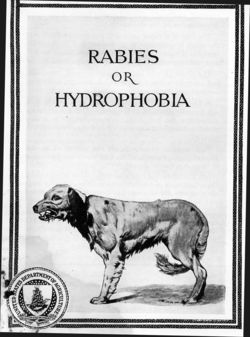(This article is excerpted by kind permission from Dr. Barkman at the Altadena Historical Society, who tells us: "Anyone who has a dog or who has been bitten by a dog will be fascinated." By the way, you can become a member of the Society by going here.)
A Brief History of Rabies in Altadena
by Jane Brackman
President, Altadena Historical Society
In 1938 there were 21 confirmed cases of canine hydrophobia in Altadena. The same year a local veterinarian died after treating a rabid dog. You couldn’t say the epidemic arrived unannounced. Between 1900 and 1934, the county recorded 9,000 confirmed cases of rabid dogs. 86 Californians died, most in the greater Los Angeles area. By 1934, with no impound facilities (the county shelter in Downey wasn’t built until 1946), lax laws, no cash (during the teens and twenties LA spent its rabies funds on infrastructure) and 20,000 stray dogs, Los Angeles was looking down the barrel of a loaded gun.
 In 1938 the county clamped down, enforcing a strict 90 day quarantine. The Altadenan reported, “All dogs must be confined on the owner’s premises at all times. Dogs cannot be taken out on a leash or in automobiles. All dogs, whether licensed or not, will be picked up by patrol wagons cruising the district. Five quarantine officers are assigned to Altadena.”
In 1938 the county clamped down, enforcing a strict 90 day quarantine. The Altadenan reported, “All dogs must be confined on the owner’s premises at all times. Dogs cannot be taken out on a leash or in automobiles. All dogs, whether licensed or not, will be picked up by patrol wagons cruising the district. Five quarantine officers are assigned to Altadena.”
Impounded dogs were swiftly euthanised and examined for evidence of rabies. Reports were issued by the Department of Health and announced in local newspapers.
On July 8, 1937 the paper reported that rabid dogs had been picked up at 151 Woodbury, 462 Archwood, 200 East Las Flores and one in the 800 block of Mariposa. The Department of Health kept the community informed, “so that anyone having been in contact with such an animal can be made aware of the fact and report to clinics for treatment.”
Each July 1st, dog owners were required to secure license applications at the Altadena sheriff’s sub station. The licensing fee was $1 for males, $2 for females and $1 for spayed dogs. Even though the dog vaccine was widely available as early as 1922, it was optional. Suspicious anti-regulation proponents fought successfully against government intervention for the next 18 years.
In 1938 Altadena Rotary along with Animal Control sponsored rabies inoculation clinics at Farnsworth Park. The director, Mr. Miller said, “[He] hoped that dogs would be on their best behavior.” The fee for vaccination was $2 to cover the cost of supplies, fairly pricey considering the average annual income was less then $900.
As the epidemic waned the quarantine was eased. Dogs were allowed on leashes and in automobiles but could not run at large. However stray dogs off property or without licenses identifying owners continued to be euthanised indiscriminately. Pet lovers protested, accusing the county of rewarding dogcatchers with a $1 bounty for each impounded dog. Some dogs were stolen or even held for ransom. The county denied the rumors, but “ruled that stray dogs must be impounded at least ten days before destroying them thus giving owners time to reclaim them. As a result, dog catchers must keep off private property in their roundup of canines.”
The epidemic subsided through the war years but came back with a vengeance in the mid 1950s. The final showdown in the long battle over compulsory dog inoculation finally ended. In 1956 all dogs were required to be vaccinated as a prerequisite to licensing. The county paid for and vaccinated thirty thousand dogs. The ordinance worked so well that the state legislature followed suit and passed a similar law. Following mandatory rabies vaccination, within ten years the disease had all but disappeared from the pet dog population.
Full article is here: http://www.altadenahistoricalsociety.org/echos/fof/Rabies.pdf
Ed. Note: we actually have a favorite rabies scene. This is it:
----------



